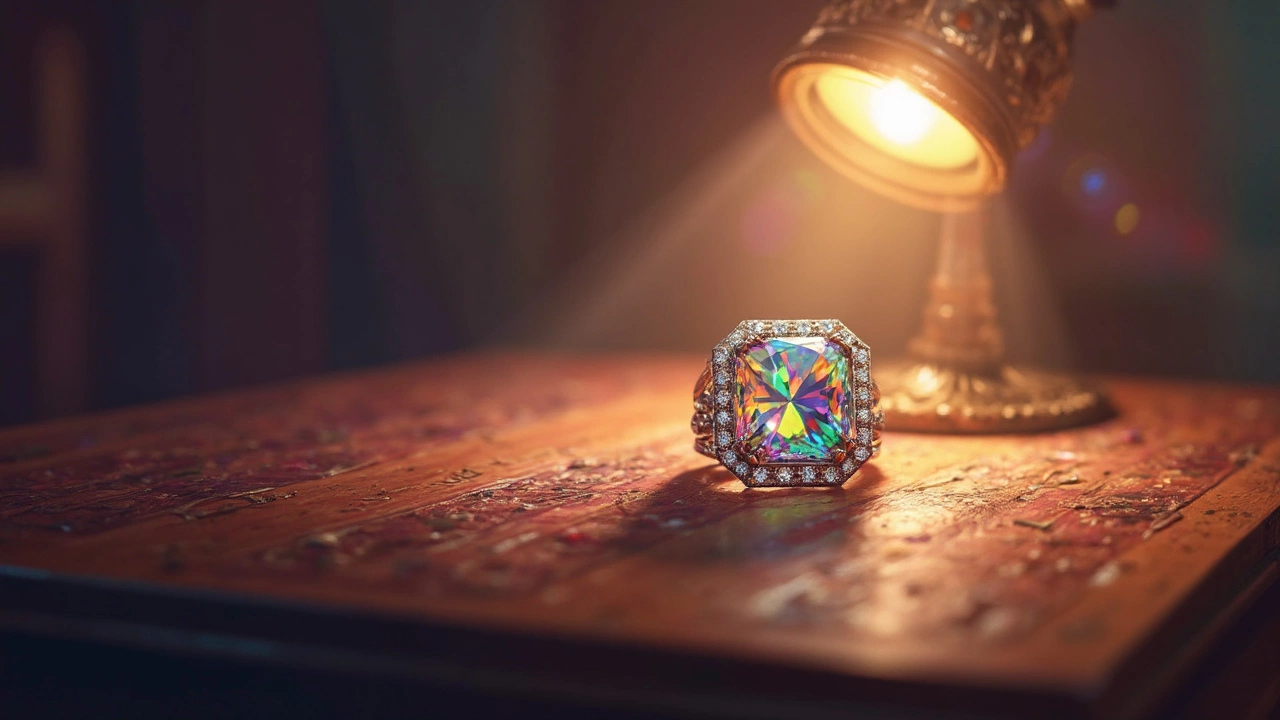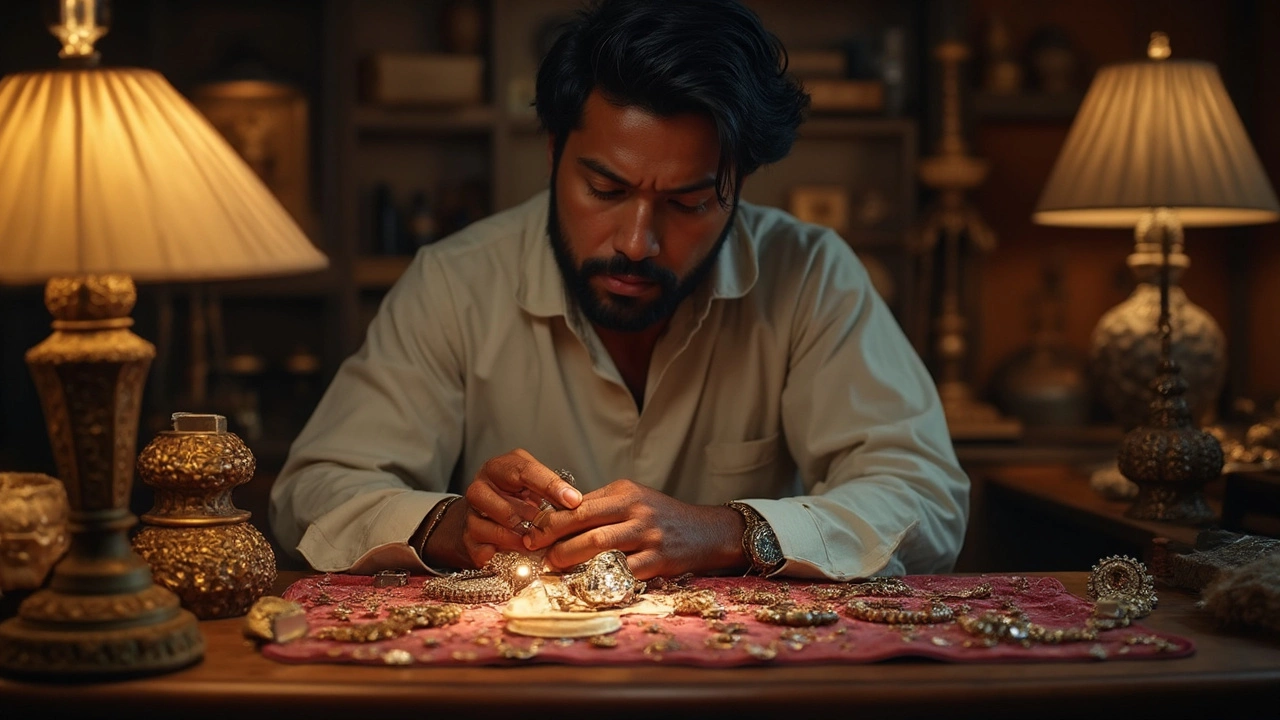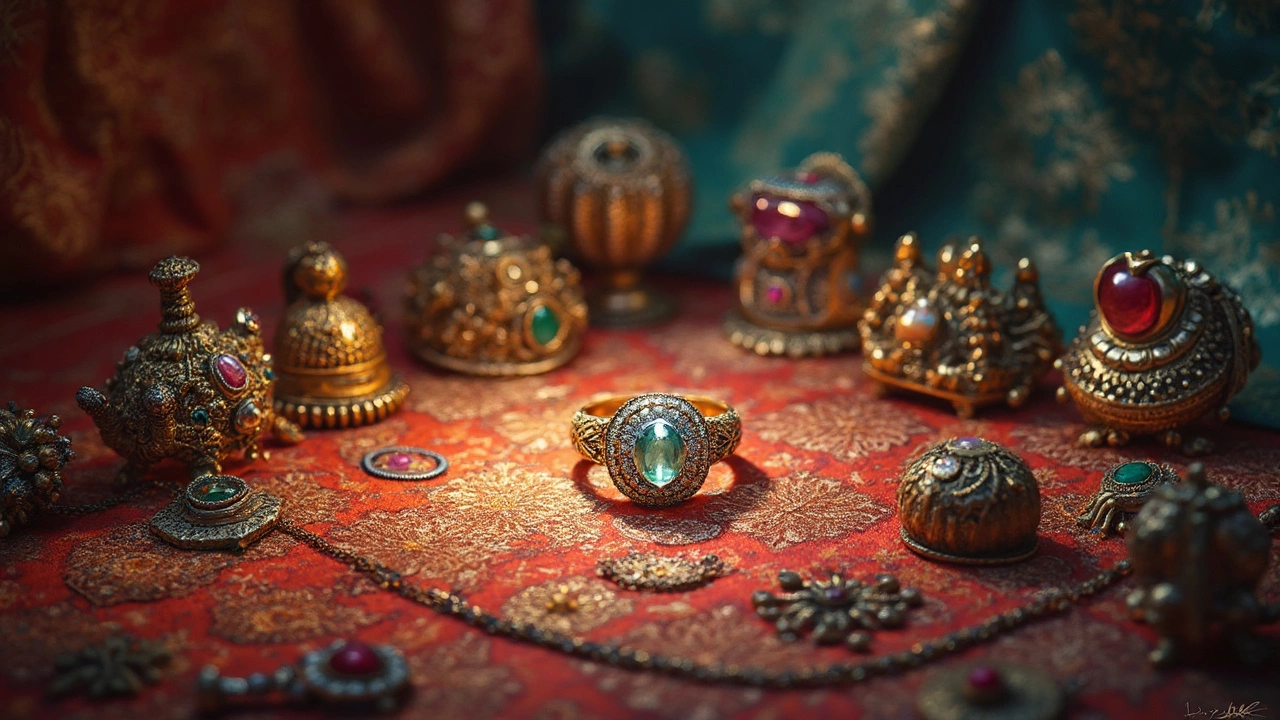
Wondering if that diamond ring you found in grandma's attic is the real deal? A flashlight might be all you need to find out. It sounds a bit like magic, but it's pretty straightforward once you get the hang of it.
First, you'll want to hold the diamond under the flashlight. A real diamond boasts incredible brilliance. When light hits it, you should notice a rainbow of colors reflecting back. This light play is due to the stone's refractive properties.
But there's more to this than just sparkles. Ever heard of the 'halo' effect? It's when light creates a circular reflection around genuine diamonds. Give it a try and see if there's a ring of light surrounding the stone when you shine that flashlight directly overhead.
- The Science Behind Diamond Sparkle
- Flashlight Method Explained
- Observing Color and Clarity
- Additional Tests for Genuine Diamonds
- Tips for Buying Antique Jewellery
The Science Behind Diamond Sparkle
Understanding why a diamond sparkles the way it does can help you identify if your diamond ring is authentic. At the heart of this sparkle is something called 'dispersion.' It’s the diamond’s ability to split white light into a spectrum of colors.
So, what makes a diamond different from other stones? It all comes down to its structure. A genuine diamond ring has a unique arrangement of carbon atoms. This arrangement allows light to enter the diamond, bend, and reflect within it, before bouncing back out.
Brilliance, Fire, and Scintillation
These are the big three when it comes to evaluating a diamond’s light performance:
- Brilliance: This is about the white light reflected back from the diamond.
- Fire: Notice those rainbow flashes? That’s fire! It's the scattering of white light into all those beautiful colors.
- Scintillation: These are the flashes of light you see when the diamond, or the light source, moves. It's what gives diamonds their famous sparkle.
Next time you shine a flashlight over your stone and spot these characteristics, you might just be looking at a real diamond. Just remember: it's about how the stone handles light, not how perfect it looks at first glance.
Useful Numbers
| Characteristic | Value for Real Diamonds |
|---|---|
| Refractive Index | 2.42 |
| Dispersion | 0.044 |
| Hardness | 10 on Mohs scale |
This table gives a quick look at the numbers related to diamond light performance. If your ring doesn’t match up, it might be time to rethink that 'antique jewellery' label.
Flashlight Method Explained
We hear you: how does a humble flashlight become a master detective in determining if your diamond ring is the real McCoy? This is how it works. All you need is a dark room, a bright flashlight, and sharp eyes.
Setting the Scene
Start by taking the diamond ring into a dark room. We want that flashlight's beam to shine its full glory on the stone, making it easier to spot the telltale signs of a real diamond.
The Test Begins
Hold the flashlight right over the diamond and turn it on. Focus on the way the light interacts with the stone. A genuine diamond will reflect light in a particularly lively, colorful way due to its unique structure.
"Real diamonds have a natural brilliance and reflectiveness that is hard to mimic with imitations," says Dr. Emily Green, a well-known gemologist from the Australian Gemstone Institute.
What to Look For
- Brilliance: Genuine diamonds have a bright white sparkle known as brilliance. It's not just about standing out—it's about how the stone plays with light.
- Fire: Look for a rainbow-like color, which true diamonds produce by how they scatter light. This is technically known as "fire."
- Scintillation: When you move the stone, if the sparkling pattern seems consistent, you've likely got a real gem.
This simple yet effective method doesn't just give you peace of mind. It opens up the fascinating world of gemology, where even small details can make all the difference. Just remember, the flashlight test is handy, but it's always a good idea to get a professional appraisal if you suspect authenticity issues.

Observing Color and Clarity
When checking if your diamond ring is genuine, color and clarity play big roles. First off, real diamonds usually have a slight color tint. Completely colorless ones are rare. If you notice your stone has a hint of yellow or brown when you check it under a flashlight, it could be the real McCoy.
The next thing to check is clarity. Experts often use a grading system to determine clarity, but you can do a basic test at home. Hold the diamond up to light and look for blemishes. Most diamonds have tiny imperfections called inclusions or blemishes. If the stone looks too perfect, it might be fake.
Quick Clarity Check
- Use a magnifying glass or a jeweler's loupe if you have one.
- Look for any scratches, lines, or cloudy areas inside the stone.
- Don't freak out if you find a couple - it’s actually a good sign!
Another interesting tidbit: the Gemological Institute of America (GIA) grades diamonds on a scale from D (colorless) to Z (light color). Genuine antique pieces often fall somewhere in the lower half of this range, so finding a little color might mean you're looking at something vintage and valuable!
| Diamond Clarity Grade | Description |
|---|---|
| FL | Flawless |
| IF | Internally Flawless |
| VVS1/VVS2 | Very Very Slightly Included |
| VS1/VS2 | Very Slightly Included |
| SI1/SI2 | Slightly Included |
| I1/I2/I3 | Included |
So, next time you're examining an antique jewellery piece, remember these tips on color and clarity. They could save you from shelling out cash for a dud!
Additional Tests for Genuine Diamonds
So, you've tried the flashlight test, and now you're curious to dig a bit deeper? Good decision! There are a few other tests you can do right at home to confirm if that diamond ring is real. Let's get to it.
Water Test
A quick and easy check involves using a glass of water. Fill a glass about three-quarters full and gently drop the diamond into it. A real diamond is dense and should sink to the bottom. If it floats, you've got a faker.
Fog Test
For some quick insight, you can try the fog test. Simply hold the diamond between two fingers and breathe on it with a puff of air. Real diamonds disperse heat quickly, so if the fog clears right away, you're likely dealing with the real McCoy. If it lingers for a few seconds, it might be time to reconsider.
Read-Through Test
This one requires a piece of paper with writing on it. Place the diamond flat side down on the text and try to read through it. A genuine diamond will refract light in so many directions that you shouldn’t be able to make out the letters. If you can read them, it's a sign that you're looking at a fake.
| Test Type | Expected Result for Real Diamond |
|---|---|
| Water Test | Sink |
| Fog Test | Fog clears quickly |
| Read-Through Test | Cannot read text |
Heat Test
Feeling brave? Try the heat test. Carefully heat the stone with a lighter for about 30 seconds, then drop it into cold water. Real diamonds are incredibly resilient and won't react to sudden temperature changes. If it's a fake, it might shatter.
While these methods can be quite effective, remember that consulting a professional jeweler is always the safest way to confirm your findings. Happy testing, and may your diamond dreams come true!

Tips for Buying Antique Jewellery
When it comes to buying antique jewellery, you want to make sure you’re getting the real deal. These pieces carry history and charm, but they can also come with uncertainties. Let's dig into how to choose wisely.
Get It Authenticated
Authentication should be your first port of call. Engaging with a certified appraiser can make a world of difference. They can help verify the piece's age and origin. According to the Gemological Institute of America (GIA), authenticating jewelry requires checking specific markers, like maker's marks or hallmarks.
Understand the Style and Era
Knowing the style and era can help you determine its authenticity. Victorian, Edwardian, and Art Deco pieces each have distinct patterns and materials. "Antique jewellery tells a story, not just in its design but in the materials used," says jewellery historian Anna M. Miller.
Check the Condition
Condition is key. Small faults are normal, but excessive wear could lower value. Pay attention to restorations—it’s okay if a piece was touched up, but extensive repairs might affect authenticity.
Compare Prices
Don't settle for the first price. Research market value by checking reputable dealers or auction results.
Beware of Fakes
Reproductions are rampant in antique markets. Look for inconsistencies in craftsmanship. Genuine diamond rings often have more intricate details compared to their replicas.
| Era | Popular Gems | Common Materials |
|---|---|---|
| Victorian | Turquoise, Garnets | Gold, Silver |
| Edwardian | Diamonds, Pearls | Platinum |
| Art Deco | Sapphires, Emeralds | Platinum, White Gold |
Remember, genuine antique pieces are a valuable addition to your collection. Not only do they hold monetary value, but they also preserve a piece of history. Happy hunting!


